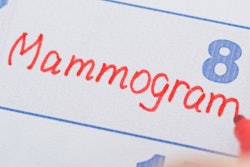A team led by Dr. Constance Lehman, PhD, measured the performance of 359 radiologists reading digital screening mammograms across 95 facilities in six Breast Cancer Surveillance Consortium (BCSC) registries. The study data included 1.6 million digital screening mammograms performed between 2007 and 2013. The group calculated performance measures according to the American College of Radiology's BI-RADS Atlas (5th edition) and compared them with benchmarks previously published by the BCSC and the National Mammography Database.
Mean performance measures were as follows:
- Abnormal interpretation rate: 11.6%
- Cancers detected per 1,000 screens: 5.1
- Sensitivity: 86.9%
- Specificity: 88.9%
- False-negative rate per 1,000 screens: 0.8
- Positive predictive value for recall: 4.4%
- Positive predictive value for biopsy: 28.6%
Although 92.1% of radiologists achieved recommended cancer detection rates and 97.1% achieved recommended ranges for sensitivity, only 59% achieved recommended abnormal interpretation rates, and 63% achieved recommended specificity.
The bottom line is that there's room for improvement, Lehman and colleagues concluded.
"The majority of radiologists in the BCSC surpass performance recommendations for screening mammography; however, abnormal interpretation rates continue to be higher and specificity lower than the recommended rates for almost half of radiologists interpreting screening mammograms," they wrote. "Efforts to implement advanced technology should be combined with effective educational programs to reduce false-positive rates without sacrificing high detection rates of invasive cancers."



















